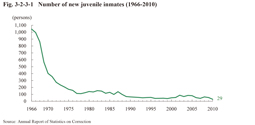Section 3 Juvenile Inmates
Fig. 3-2-3-1 shows the number of new juvenile inmates (refers to juveniles sentenced to imprisonment with or without work to serve their sentences at penal institutions) since 1966. The number exceeded 1,000 in 1966, but then decreased significantly and remained below 100 from 1988, being 29 in 2010 (down 25 from the previous year). Only one of the new juvenile inmates in 2010 was a female. By age at the time of admission (age at the time they received an indeterminate sentence of those 20 or older when admitted) two were 16-17, and 27 were 18-19. Examining the number of new juvenile inmates by their term of sentence (maximum term with indeterminate sentences) revealed that one of them were sentenced to life imprisonment, 15 to “more than 5 years but no more than 10 years,” four to “more than 3 years but no more than 5 years,” and nine to no more than 3 years. By type of sentencing, 28 were sentenced to imprisonment with work and one to imprisonment without work. By type of offense, robbery at six (robbery causing death or injury at five, rape at the scene of a robbery/rape at the scene of a robbery causing death at one) and dangerous driving causing death or injury at six were the largest in number, followed by homicide at four, Road Traffic Act violations at four, and injury at three (injury at two, injury causing death one) (Source: Annual Report of Statistics on Correction).
Fig. 3-2-3-1 Number of new juvenile inmates (1966-2010)
Juvenile inmates are considered to be still physically/mentally developing and thus also still sufficiently adaptable, and are therefore treated according to these characteristics at penal institutions. The formulation of treatment guidelines for juvenile inmates (See (1) of Subsection 1, Section 2, Chapter 4, Part 2) involves goals at each stage finely divided into introduction, development, and generalizing stages. When implementing correctional treatment consideration is given to placing a particular focus on academic guidance, enabling them to take vocational training when possible, and assigning more useful work once they do engage in general work, etc.
In addition, at least one official is designated to each juvenile inmate (individual assignment system), who then closely cooperate with the other officials and implement consistent individual guidance, including individual counseling and guidance on writing a diary, etc.
If the juveniles are serving their sentences in juvenile training schools, they are not subject to work and instead receive correctional education.
